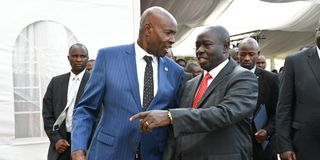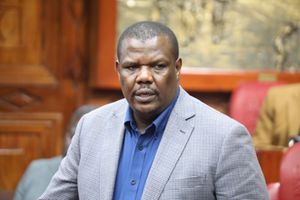Happening Now: LIVE: Agriculture CS Mithika Linturi's impeachment trial
Here’s what is ailing university education and how to fix it

Deputy President Rigathi Gachagua (right) confers with Education CS Ezekiel Machogu during the launch of the 2022 exam season at Mitihani House on November 11, 2022.
Funding of university education has dominated public discourse in recent weeks underpinning a fundamental challenge the country has to confront.
Education Cabinet Secretary Ezekiel Machogu upped the ante last week with the declaration that the government will stop funding the public universities.
Although he recanted the statement a day later and gave an assurance that the State will continue financing the institutions, the message was out there.
Public universities are at crossroads and require no less than a Marshall Plan to pull them out of the rut.
At the core are several interlocking issues, first, the public universities are underfunded and heavily indebted, cumulatively, operating a debt portfolio of Sh56 billion.
The worst hit are the old universities, Nairobi, which has a deficit of Sh2.173 billion, Kenyatta University Sh2.137 billion, Jomo Kenyatta University of Agriculture and Technology Sh1.4 billion, Egerton Sh1.311 billion and Moi 1.06 billion.
Most of the universities are unable to pay salaries on time, affecting staff performance. Worse, part-time lecturers who constitute the bulk of university teachers, have not been paid for more than two years and are collectively owed Sh4.5 billion.
In the current financial year, the government allocated Sh544 billion to the education sector and out of this, Sh91.2 billion was earmarked for public universities.
However, this falls short of what the universities require. According to the Universities Funding Board (UFB), the budgetary allocations still leave the universities with a deficit of Sh68.3 billion.
Since 2017/18 financial year, the formula for funding universities changed to what is referred to as differentiated unit cost (DUC) instead of a flat rate model that funded all courses equally at the rate of Sh120,00 a year.
The objective of DUC was to ensure that degree programmes and universities were funded in a realistic manner.
Under the DUC, courses such as medicine, architecture and engineering that require a lot of resources and inputs are costed highly compared to the social sciences and humanities.
For example, the unit cost for medicine is Sh720,000 annually, architecture Sh432,000 and engineering Sh396,000.
Comparatively, humanities and social sciences cost Sh144,000 annually. However, the DUC model has not been implemented to the letter and therefore has not achieved the envisaged returns.
The situation is not any better for the Higher Education Loans Board (Helb).
According to Helb’s strategic plan 2019-2023, it requires at least Sh19 billion annually to fund students in the universities.
However, in the current financial year, it was allocated Sh15.8 billion, which leaves a significant deficit.
Matters are aggravated for Helb because its funding model is based on the old formula of funding universities at a flat rate of Sh120,000 a student. Thus, it allocates between Sh37,000 – Sh60,000 to the students depending on needs, yet the funding ought to be based on the differentiated unit cost.
According to Helb, the minimum figure that should be awarded to a student under the DUC formula is Sh122,000 annually.
Although the universities have been struggling for years due to cuts of government funding, the situation deepened in recent years with the death of parallel degree programmes, officially known as Module II, which had evolved as money minting enterprise for the institutions.
And the collapse of Module II programmes came with the elimination of cheating in Form Four exams in 2016, which drastically reduced the number of candidates qualifying for university education.
Since, all Kenya Certificate of Secondary Education (KCSE) candidates who attain grade C+ and above are admitted to the university, leaving no admission pool for parallel degree programmes.
Even so, there is a sub-text to this. Since 2016, the government through the Kenya Universities and Colleges Central Placement Service (KUCCPS) has been admitting and placing some qualifiers in private universities and paying their capitation fees, in a policy move that was meant to reduce overcrowding in public universities.
However, this has elicited profound challenges. Private universities benefit from government funding at the expense of public universities. Students are also admitted to universities and courses they never applied for.
The second and critical challenge facing universities is quality and relevance. Due to the cash crisis, the universities are unable to expand facilities and maintain existing ones in good condition.
Science and technology programmes are severely affected because of lack of laboratories and equipment.
Similarly, the universities are unable to recruit and retain top notch academics to guarantee quality of teaching. Research and outreach mission are largely ignored.
Third is the mismatch between courses offered at the universities and the skills learners require to enter the job market.
A 2018 study by the Kenya Institute for Public Policy Research and Analysis (Kippra) on graduate employment in Kenya reported that many employers were concerned about the mismatch between skills gaps among graduates, stating education and training were not giving the outcome required in the job market.
The study entitled: “Employment Distribution of Youth Graduates Across Economic Sectors” observed that many graduates stayed for an average of 18 months after graduation before getting a job, a factor underscoring the challenge of university education.
According to a report by the Commission for University Education, the bulk of academic programmes are skewed to education, social sciences and humanities at the expense of science, technology, engineering and mathematics.
The report notes, for example, that during the 2017/18 academic year, there were 134,202 students enrolled in business administration, accounting for 23.8 per cent of the total enrolments, while education had 122,558, or 21.7 per cent.
Enrolments in education degree programmes is vexing. While the numbers are growing, the Teachers Service Commission (TSC), the main employer, only absorbs 5,000 additional teachers every year plus replacing those who have retired, resigned or died.
Essentially, the universities are investing in producing large number of teachers who do not have a chance of getting employed soon after graduation.
Fourth is political interference in the management of universities, a tradition that has gone for decades despite express legal provisions to tame it.
In one of his last pronouncements at the ministry, former Education CS George Magoha told the Presidential Working Party on Education Reforms that public universities were suffocating due to political interference. He asked the new administration to stop creating new universities to serve political interests.
Historically, every successive administration has sought to expand public universities but with mixed results. The Kanu administration under former President Daniel arap Moi set the tempo in the late 1980s by establishing new universities to absorb increasing number of high school leavers but which motive was superseded by instinctive political interests.
Between 1984 and 1994, President Moi created five universities, raising the total to six. President Mwai Kibaki created 15 universities, raising the number from seven in 2007 to 22 in 2013. Under President Uhuru Kenyatta, created 14, raising the number from 22 to the current 36 public universities with six constituent colleges.
Additionally, there are 25 fully-fledged private universities, three constituent colleges and eight operating with Letters of Interim Authority.
The cumulative effect of the unplanned expansion is that the government has to carry the burden of funding universities even when the returns are minimal. Which raises the question, what next? This is part of what the Working Party on Education Reform under Prof Raphael Munavu has to deal with.
Even so, studies and experience elsewhere indicate that governments must plan properly for university education, carefully projecting the enrolments based on school population, mounting courses required by the market, diversifying funding models and incentivising the private sector to support higher education.
In the immediate terms, public universities will require major internal reorganisation, rethink their academic programmes, downsize the staff and offload non-core functions like transport, cleaning and accommodation.
David Aduda is Consulting Editor, [email protected]





